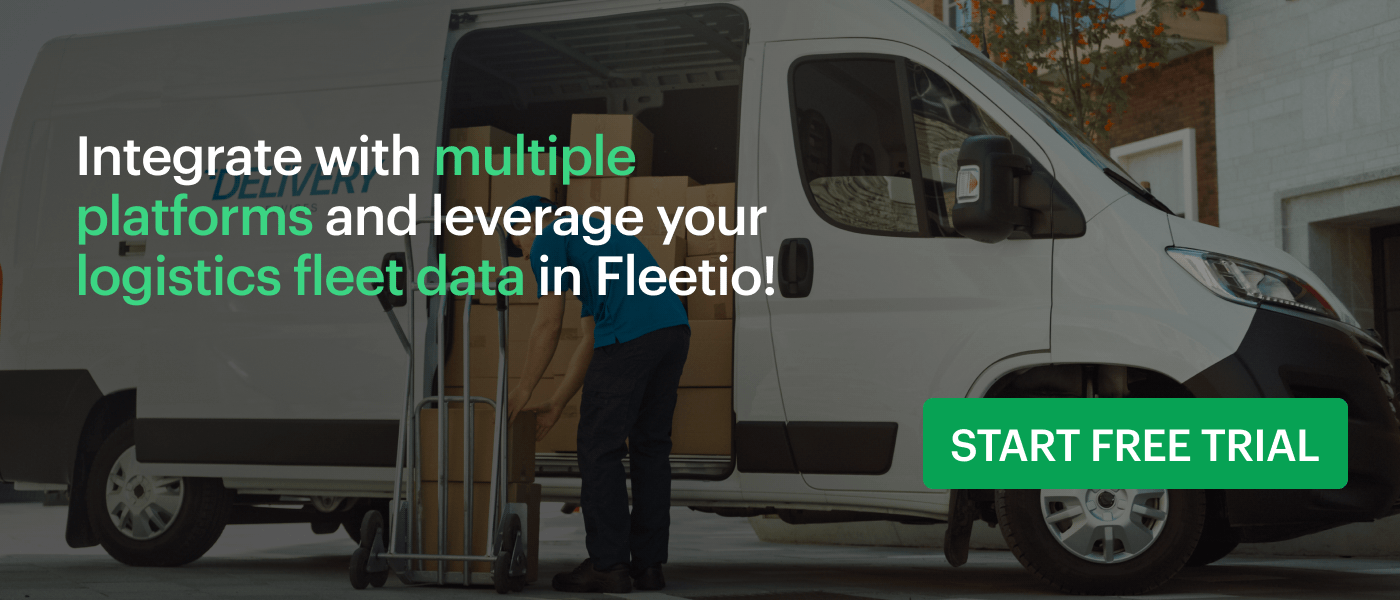When it comes to the day-to-day processes of running a logistics operation, every fleet has room for improvement. Here are a few ways to boost your logistics fleet management strategy and streamline your organization.

1. Implement a Fleet Management Software
When you try to manage your fleet through more traditional means, like paper logs and other physical records, it’s easy to lose track of the important indicators that come up in your operation every day. While digitizing your data into cloud-based spreadsheets and documents can help, you’ll want a truly integrated solution that synchronizes all of your fleet’s moving parts and allows you to truly work smarter, not harder.
Implementing a fleet management software can be a powerful step that enables so many of the other facets of successful fleet operation. When you make the switch to a fleet management software like Fleetio, you put a system in place to leverage all of your data in one location, from integrating with telematics devices and maintenance shops to coordinating service schedules with alerts and reminders.
Not only do you get better access to the metrics that move your fleet forward, you eliminate the time suck of manual data entry and prioritize quick collaboration with drivers and technicians through fast, mobile-friendly platforms.

2. Utilize Your GPS and Telematics Devices for More Than Location
Logistics fleet managers rely on location to keep tabs on their assets and routes, meaning that GPS and telematics devices are critical to both federal compliance and day-to-day operations. But many fleet managers don’t realize that the data that comes from those devices can be a lot more valuable when it’s integrated with the right fleet management software.
While you can use your telematics provider alone to determine driver locations, you miss out on key insights when you view that data in isolation. Supplementing telematics data with fleet management software helps you streamline maintenance processes and receive real-time odometer updates, inspection results and diagnostic trouble codes (DTC), which helps you avoid downtime and keep your vehicles and drivers on schedule.
You can also use data traditionally attributed to driver behavior to get better insight into the overall health of your vehicles. For example, telematics devices highlight unsafe behaviors like hard braking, which can lead to more service requests for a vehicle’s brakes over time.
3. Switch to Electronic Driver Vehicle Inspection Reports for Speed and Compliance
Driver vehicle inspection reports (DVIRs) are the key to keeping your assets on the move and your company on schedule, between their ability to aid in preventive maintenance and their requirement for federal compliance for commercial fleets. But when drivers are required to complete DVIRs on paper day in and day out, it can become a massive impediment that threatens not only the condition of your vehicles, but the safety of your operation as well.
DVIRs completed by hand present numerous issues to both drivers and fleet managers. They can be a physical burden to complete as drivers assess their vehicles and write down comments simultaneously, which means they can often be hard to read when it comes time to enter them into a computer, which means more valuable time spent on menial processes.
Paper DVIRs can also be easily misplaced, which can be a huge risk during audits and road checks. With so many hurdles in the process, it can be hard to incentivize DVIR compliance as a whole.
Electronic DVIRs, or eDVIRs, solve a lot of these issues by streamlining the inspection process and making it easier to get the information you need on your assets and maintain compliance. When you utilize eDVIRs in a fleet management software, it allows you to set predetermined criteria for inspections that any paper form would contain, make those fields required so they can’t be skipped, and see issues as they’re submitted in real time from a driver’s smartphone or tablet.
Because they’re easier to complete, you’re more likely to maintain a consistent bank of DVIRs for each of your vehicles, and with the forms coming directly through your fleet management software, there’s no need for additional data entry, saving you time that you and your drivers both can reallocate to other tasks. Even if you don’t run a commercial fleet, eDVIRs present an incredible benefit to keep a more granular perspective on service and downtime as incidents occur, and you ultimately save money on repairs in the long run.
4. Leverage Fuel and Maintenance Data Better with Integrations
Fuel and maintenance are two of the biggest pieces of the budget pie in transportation and logistics, so keeping a close eye on spending and data in those two categories can make or break the success of a fleet operation. Normally, to get all of that data immediately visible in a singular spot, fleet managers would have to manage multiple manual data pulls and uploads from multiple sources on a regular basis, which can take a lot of time and leave gaps in the reporting process.
Using a fleet management software instead opens the door to so many different integrations with management tools you might already be using, uniting all of the relevant data you use every day without the manual effort and making it easier to analyze, derive insights and report on that data.
Some fleet management platforms like Fleetio even have an open API that with just a little bit of coding allows fleet managers to integrate with any platform they use on a daily basis, regardless of whether or not an integration exists.
Sync fuel cards
Fuel cards can be a hugely beneficial tool for keeping track of fuel data, but when they’re integrated into a fuel management platform, fleet managers can track expenditures that factor into total cost of ownership (TCO), as well as keep tabs on fuel economy to quickly spot vehicle inefficiencies. It also reduces the threat of fuel theft by allowing you to forgo the issue of lost receipts and track fueling locations in conjunction with GPS.
Manage outsourced maintenance providers
For fleets that outsource their maintenance and repairs, keeping track of costs with external providers can be tricky. With Fleetio, you can integrate with your approved third-party vendors to streamline repair approval processes and gain direct insights into your maintenance spend.
5. Track Expenses More Effectively
While fuel and maintenance constitute the majority of logistics fleet expenses, effective budgeting requires attention to all of the individual moving parts that make up your bottom line. Fleet management software lets you get down into the nitty-gritty details of your expenditures to have a full-spectrum view of what it takes to keep your fleet from running over budget.
You can set financial goals for your operation based on any of the metrics you track within your platform to use as a gauge of your solvency. Being able to accurately measure things like TCO requires looking at every cost that goes into the maintenance of any and all of your assets, and a spreadsheet alone can’t fully cover the details you need to make decisions for your fleet.
Automatically tracking expenses in a fleet management software means that information is readily available at any time, so you can ensure constant budget adherence. You also have the ability to generate thorough financial reports for more effective fleet analysis, reports that can be easily distributed to any and all stakeholders involved for easy organizational visibility.
Fleetio can help you take your logistics fleet beyond paper and spreadsheets. Start your free trial or request a demo today!



